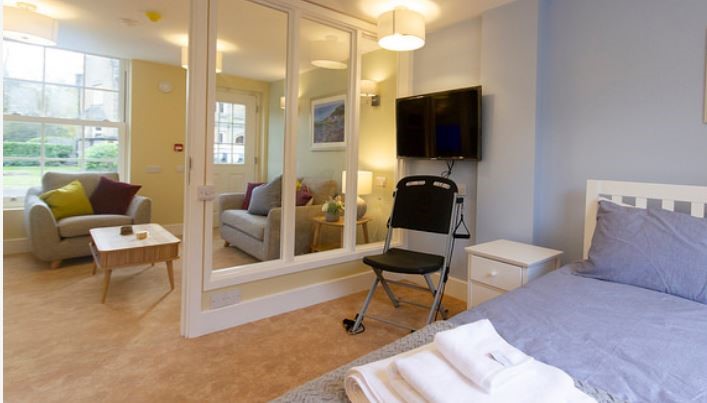Adapting homes for dementia
Research at the BRE Innovation Park has developed a method for assessing the effectiveness of measures taken to create supportive environments for those with dementia.

|
| As part of the development of the demonstration house, launched in July 2018, 12 key factors affecting people living with dementia were identified. These have been used to develop an adaption assessment method. |
Contents |
[edit] Introduction
Home adaptation to deal with an ageing population and the increasing occurrence of dementia is currently fragmented and often driven by grant funding, product marketing and market research by individuals, rather than by research-based information.
As part of the development of the dementia-friendly demonstration house (‘Chris and Sally’s House’) at the BRE Innovation Park, 12 parameters common in most housing were identified as having both negative and positive effects on someone living at home with dementia. There has been, however, a lack of knowledge concerning the influence of such parameters on building performance, and a lack of a means for assessing the effectiveness of measures taken to create supportive environments for those with dementia.
[edit] The project
This BRE Trust supported project has developed a means for creating consistency around how buildings should be adapted for dementia, and a methodology for assessing the impact of dementia adaption measures. The parameters for dementia design were tested with stakeholder groups, and a first version of a home adaption guide methodology and scoring mechanism was developed. These were then finalised after being ‘road-tested’ in two pilot projects.
[edit] Impact
This project could see a shift in how home adaptation for an ageing population (and dementia) is perceived, specified and delivered. The methodology and scoring system will give consistency and credibility to the adaptation of buildings, and will be applicable to all properties. In addition, it may influence changes in associated standards and regulations. The project could also lead to greater adaptation capacity being embedded in new-build housing to reflect changing demographics and the new models of care being proposed.
[edit] Next step
The next step in this work will be to progress six opportunities identified by the project team to deploy the methodology in ‘real’ development projects.
You can find out more at: https://www.bregroup.com/ipark/parks/england/buildings/dementia-friendly-home/
[edit] Related articles on Designing Buildings Wiki
- A Home to Remember.
- An ageing population - Challenges for the built environment.
- BRE articles on Designing Buildings Wiki.
- Changing lifestyles.
- Daylight benefits in healthcare buildings.
- Dementia and the built environment.
- Dementia-friendly home.
- Homes and ageing in England.
- Inclusive design.
- Lifetime homes.
- Lifetime Homes Design Guide (EP 100).
- Older people.
- People with disabilities.
- The cost of poor housing to the NHS.
- The design of extra care housing for older people and its impact on wellbeing: The East Sussex perspective.
Featured articles and news
One of the most impressive Victorian architects. Book review.
RTPI leader to become new CIOB Chief Executive Officer
Dr Victoria Hills MRTPI, FICE to take over after Caroline Gumble’s departure.
Social and affordable housing, a long term plan for delivery
The “Delivering a Decade of Renewal for Social and Affordable Housing” strategy sets out future path.
A change to adoptive architecture
Effects of global weather warming on architectural detailing, material choice and human interaction.
The proposed publicly owned and backed subsidiary of Homes England, to facilitate new homes.
How big is the problem and what can we do to mitigate the effects?
Overheating guidance and tools for building designers
A number of cool guides to help with the heat.
The UK's Modern Industrial Strategy: A 10 year plan
Previous consultation criticism, current key elements and general support with some persisting reservations.
Building Safety Regulator reforms
New roles, new staff and a new fast track service pave the way for a single construction regulator.
Architectural Technologist CPDs and Communications
CIAT CPD… and how you can do it!
Cooling centres and cool spaces
Managing extreme heat in cities by directing the public to places for heat stress relief and water sources.
Winter gardens: A brief history and warm variations
Extending the season with glass in different forms and terms.
Restoring Great Yarmouth's Winter Gardens
Transforming one of the least sustainable constructions imaginable.
Construction Skills Mission Board launch sector drive
Newly formed government and industry collaboration set strategy for recruiting an additional 100,000 construction workers a year.
New Architects Code comes into effect in September 2025
ARB Architects Code of Conduct and Practice available with ongoing consultation regarding guidance.
Welsh Skills Body (Medr) launches ambitious plan
The new skills body brings together funding and regulation of tertiary education and research for the devolved nation.
Paul Gandy FCIOB announced as next CIOB President
Former Tilbury Douglas CEO takes helm.























